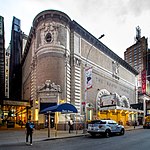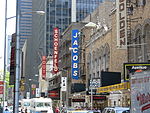Shubert Alley

Shubert Alley is a pedestrian alley in the Theater District of Midtown Manhattan in New York City. The alley, a privately owned public space, connects 44th and 45th Streets and covers about 6,400 square feet (590 m2). It runs through the middle of a city block, parallel to Eighth Avenue to the west and Broadway to the east. The western half of the alley abuts the Shubert and Booth theaters, while the eastern half is adjacent to One Astor Plaza. Because it is near several major theaters, the alley has been considered the geographical center of Broadway theatre. The alley was built along with the Shubert and Booth theaters in 1913. The Shubert family parked their cars in the alley, which was gated and locked at night. Actors would gather in the alley while waiting to try out for parts, lining up along the western wall. In the 1930s, the alley was fenced off and part of it was used as a bus terminal. The eastern half of the alley, which faced the Astor Hotel, was rebuilt when the hotel was demolished in 1967. A northward extension of Shubert Alley opened in the 1980s when the New York Marriott Marquis was built. The alley continues to serve as a theater fire exit and has also hosted several events during its history, including Broadway Cares/Equity Fights AIDS benefits and the annual Stars in the Alley concert.
Excerpt from the Wikipedia article Shubert Alley (License: CC BY-SA 3.0, Authors, Images).Shubert Alley
Shubert Alley, New York Manhattan
Geographical coordinates (GPS) Address External links Nearby Places Show on map
Geographical coordinates (GPS)
| Latitude | Longitude |
|---|---|
| N 40.758111111111 ° | E -73.986944444444 ° |
Address
Shubert Alley
Shubert Alley
10036 New York, Manhattan
New York, United States
Open on Google Maps











